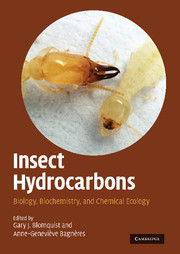Book contents
- Frontmatter
- Contents
- List of contributors
- Foreword
- Acknowledgments
- Part I Chemistry, Biochemistry, and Physiology
- Part II Chemical Communication
- 10 Perception and olfaction of cuticular compounds
- 11 Nestmate recognition in social insects and the role of hydrocarbons
- 12 Cuticular hydrocarbon cues in the formation and maintenance of insect social groups
- 13 Hydrocarbon profiles indicate fertility and dominance status in ant, bee, and wasp colonies
- 14 Chemical deception/mimicry using cuticular hydrocarbons
- 15 Behavioral and evolutionary roles of cuticular hydrocarbons in Diptera
- 16 Contact recognition pheromones in spiders and scorpions
- 17 Hydrocarbons as contact pheromones of longhorned beetles (Coleoptera: Cerambycidae)
- 18 Polyene hydrocarbons, epoxides, and related compounds as components of lepidopteran pheromone blends
- 19 Volatile hydrocarbon pheromones from beetles
- 20 Future directions in hydrocarbon research
- Index
18 - Polyene hydrocarbons, epoxides, and related compounds as components of lepidopteran pheromone blends
from Part II - Chemical Communication
Published online by Cambridge University Press: 18 May 2010
- Frontmatter
- Contents
- List of contributors
- Foreword
- Acknowledgments
- Part I Chemistry, Biochemistry, and Physiology
- Part II Chemical Communication
- 10 Perception and olfaction of cuticular compounds
- 11 Nestmate recognition in social insects and the role of hydrocarbons
- 12 Cuticular hydrocarbon cues in the formation and maintenance of insect social groups
- 13 Hydrocarbon profiles indicate fertility and dominance status in ant, bee, and wasp colonies
- 14 Chemical deception/mimicry using cuticular hydrocarbons
- 15 Behavioral and evolutionary roles of cuticular hydrocarbons in Diptera
- 16 Contact recognition pheromones in spiders and scorpions
- 17 Hydrocarbons as contact pheromones of longhorned beetles (Coleoptera: Cerambycidae)
- 18 Polyene hydrocarbons, epoxides, and related compounds as components of lepidopteran pheromone blends
- 19 Volatile hydrocarbon pheromones from beetles
- 20 Future directions in hydrocarbon research
- Index
Summary
Moth species rely heavily to exclusively on sex attractant pheromones for long-range location of mates. In most but not all species, the attractant pheromone is produced by females, and males have evolved extremely sensitive antennae, the receptors of which are tuned specifically to detect the scent of conspecific females. It is clearly a very effective mate location system, because male moths have been shown to be attracted to females over distances of a kilometer or more (Mell, 1922; Collins and Potts, 1932), despite the fact that females may only produce micrograms to nanograms of pheromone per hour. To be effective as long-range, species-specific attractants, sex attractant pheromones should fit several criteria. First, they must have sufficient vapor pressure under ambient temperature conditions to provide a detectable signal for males to find and follow. Thus, attractant pheromones are relatively small molecules, with most having molecular weights of less than 300 Daltons. They also tend to have few or even no polar functional groups, because polar functional groups decrease volatility. Second, the individual components of the pheromone, or the blend of components, must be sufficiently distinctive that they form a unique, species-specific blend, so that there is no cross-attraction among sympatric species (see Chapter 7). Whereas there are cases known in which species appear to produce unique compounds, the majority of insects appear to create species-specific signals by blending two or more compounds, each of which may be shared by several species, in specific ratios.
- Type
- Chapter
- Information
- Insect HydrocarbonsBiology, Biochemistry, and Chemical Ecology, pp. 390 - 447Publisher: Cambridge University PressPrint publication year: 2010
- 8
- Cited by



